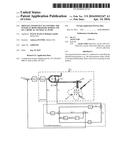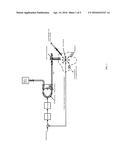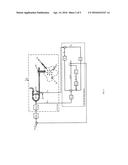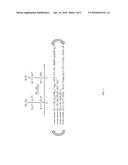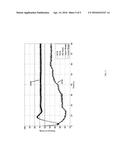Patent application title: Process and Device to control the internal body pressure during use of a medical-technical pump
Inventors:
Andreas Zeyssig (Berlin, DE)
IPC8 Class: AA61M1300FI
USPC Class:
604 26
Class name: Means for introducing or removing material from body for therapeutic purposes (e.g., medicating, irrigating, aspirating, etc.) gas application gas injected into body canal or cavity
Publication date: 2016-04-14
Patent application number: 20160101247
Abstract:
The present invention relates to a method for controlling the internal
body pressure, e.g., the joint pressure using a medical-technical fluid
pump, and to a device for carrying out said method.Claims:
1. A method for determining and controlling the internal body pressure in
medical methods comprising the steps of: pumping a fluid by a pumping
device via a supply line into a body cavity, wherein the fluid is able to
flow through a second line out of the body cavity, and wherein the fluid
is able to flow through a separate skin incision of the body cavity,
controlling the pump comprised in the pumping device, wherein an input
speed being the effective control variable for a state observer and at
least the supply line containing a pressure sensor measuring the pressure
in the line, wherein the pressure measured by the pressure sensor is a
measurable state variable for calculating an observer error for a state
observer, the state observer being described by a state space model,
which describes the mathematical-physical relation, which estimates the
actual pressure in the body cavity and controls the power of the pump by
means of this estimated value.
2) The method according to claim 1, wherein the mathematical estimation system is configured as a state observer.
3) The method according to claim 2, wherein the state observer is configured in a continuous or discrete-time manner.
4) The method according to claim 1, wherein the fluid is a gas.
5) The method according to claim 1, wherein the fluid is a liquid.
6) A medical-technical device for introducing fluids into body cavities, comprising a controllable fluid pump, a supply line, a pressure sensor in the supply line, wherein the device is configured to carry out the method according to claim 1.
7) The medical-technical device according to claim 6 further comprising at least one microprocessor, at least one memory, and at least one software.
8) The medical-technical device for introducing fluids into body cavities according to claim 7, wherein the device is an insufflator.
9) The medical-technical device for introducing fluids into body cavities according to claim 7, wherein the device is a liquid pump for arthroscopy, urology, hysteroscopy, laparoscopy.
10) A method for determining and controlling the internal body pressure in medical methods comprising the steps of: conducting a fluid by means of a controllable supply unit and a connected supply line into a body cavity, controlling the valve comprised in the supply unit, wherein an input volume flow being the effective control variable for a state observer and at least the supply line containing a pressure sensor measuring the pressure in the supply line, wherein the pressure measured by the pressure sensor is a measurable state variable for calculating an observer error for a state observer, the state observer being described by a state space model, which describes the mathematical-physical relation, which estimates the actual pressure in the body cavity and controls the supply unit of the insufflator by means of this estimated value.
11) A medical-technical device for introducing fluids into body cavities, comprising a controllable valve, a supply line, a pressure sensor in the supply line, wherein the device is configured to carry out the method according to claim 10.
Description:
BACKGROUND OF THE INVENTION
[0001] The present invention relates to a method for controlling the internal body pressure, e.g., the joint pressure using a medical-technical fluid pump, and to a device for carrying out said method.
[0002] During various medical interventions in the body interior, fluids, e.g., gases or liquids are introduced into the body interior and are removed therefrom. An example is arthroscopy, where, for instance for the purpose of a knee joint examination or a therapeutic treatment, the knee is rinsed with a rinsing liquid. Another exemplary treatment is laparoscopy, where during a therapeutic intervention, gases (e.g., CO2) are supplied to the body interior. For these procedures, measuring, controlling, and in particular limiting the pressure in the body interior is very important. During therapeutic interventions, it is in particular necessary, to guarantee a certain fluid flow, in order to rinse off for instance smoke or blood from the body interior, simultaneously however to limit the pressure, in order to not unnecessarily damage the body tissue. For this purpose, various solutions can be found in prior art. A simple solution of the problem is to introduce a pressure sensor immediately into the body interior. The disadvantage of this solution is, inter alia, that additional space in the body interior is required, which is not available in particular for small body cavities (e.g., for arthroscopy). Furthermore, every additional duct into the body interior will increase the risk of infection being always present.
[0003] Another solution is to measure the pressure in the supply line. This pressure, however, differs more or less from the actual pressure in the body interior, due to the flow-dynamic conditions in the supply and discharge lines. Since this difference of the measured pressure from the actual value depends in a non-linear way on a series of parameters (e.g., flow speed, length of lines, diameter of lines, etc.), a simple correction is not possible.
[0004] Given this background, it is the object to provide a method for measuring, controlling, and in particular for limiting the pressure, which overcomes the above disadvantages. For achieving this object, the method according to claim 1 is proposed. Advantageous embodiments are subject matter of the sub-claims referred back to claim 1. Furthermore, a device for carrying out the method according to claim 5 is proposed. Advantageous embodiments are subject matter of the sub-claims referred back to claim 5.
SUMMARY OF THE INVENTION
[0005] The method according to the invention is substantially based on that for measuring and controlling the internal body pressure, a mathematical model of the control section is used. For this purpose, the complete system consisting of pump motor, supply line, pressure sensor, medical insertion device (e.g., trocar with optical system), body cavity and fluid outlet (e.g., suction device) are described by a set of differential equations and summarized in a so-called state space model. Provided that the parameters of the model have been determined sufficiently precisely, there follows, with the same input variable, an estimation for the sensor pressure and the pressure in the body interior. By a comparison between the actual pressure and the estimated sensor pressure, deviations (so-called observer errors) can be detected. These may be caused, for instance, by different initial states (e.g., at the beginning of the operation, there is no information about the internal body pressure) or by a noisy measurement signal of the pressure sensor. If the observer error is fed back by using a feedback gain to the input of the state space module, the error will decay, and as a result, a precise estimation for the pressure in the body interior is obtained. The advantage of the proposed method is, inter alia, that for the measurement of the internal body pressure, no additional pressure sensor is required. As a result, a distinctly better measurement of the internal body pressure is obtained, even under modification of the influencing variables, such as, e.g., the discharge of liquids or when switching a suction pump on, or the like.
[0006] Preferably, the method according to the invention is configured such that the estimation system is realized as a state observer. Such state observers are explained, e.g., in textbooks of control engineering. Depending on the actual problem, weighting matrices can be taken into account in the state observer, which represent a possible system and measurement noise. This can be caused, on the one hand, by stochastically acting process interferences or by deficiencies of the sensor system. Thereby, the result of the estimation of the state variable to be reconstructed can be improved. The type of state observer may be configured in a continuous or discrete-time manner, and this applies for linear and non-linear systems. Examples of state observers include: linear and non-linear Luenberger observer for deterministic system behavior, linear and non-linear Kalman filter for deterministic and stochastic system behavior, high-gain observer for deterministic systems (feedback gain is set such that the linear portion of the system dominates), etc.
[0007] A particular embodiment of a device realizing the above method is a peristaltic hose pump, as it is used, for instance, in arthroscopy. It contains a controllable motor supplying the peristaltic pump power. Via a supply line (e.g., hose and a trocar with optical system) the pumped liquid is conducted into the body interior (e.g., the knee joint). From the knee joint, the liquid can be discharged in different ways. Either via a separate skin incision or via additional discharge lines for draining and shaver. The latter are often connected to a suction or vacuum pump. By the method according to the invention, the actual pressure in the joint is estimated using the measurement data of the pressure sensor and is controlled by the pump motor.
[0008] An alternative embodiment of the invention provides an insufflator, as it is used for laparoscopy. By means of the insufflator, a gas is conducted into the body interior (e.g., the abdomen). Gas discharge from the body interior is realized, here too, for instance, by an extraction line. Here too, a pressure measurement is made in the supply line. The actual pressure in the body interior is estimated by the method according to the invention and serves for controlling the insufflator. As a result, a device is obtained that ensures a precise measurement and control of the pressure even under extreme conditions, e.g., when switching a suction device on and off.
BRIEF DESCRIPTION OF THE DRAWINGS
[0009] FIG. 1 shows a direct fault-free pressure measurement in the joint, a pump is controlled, which ensures the liquid flow into the joint.
[0010] FIG. 2 shows the actual pressure in the joint is estimated based on the input speed of the pump motor and the data of the pressure sensor in the hose using a state observer.
[0011] FIG. 3 shows a flowchart of the software module.
[0012] FIG. 4A shows the measured sensor pressure is compared to the estimated sensor pressure.
[0013] FIG. 4B shows the measured joint pressure is compared to the estimated joint pressure.
[0014] FIG. 4C shows the liquid discharge estimated by the Kalman filter.
[0015] FIG. 5 shows the results of comparative measurements of a classic peristaltic pump with a pressure sensor in the supply line (designated A114) and a pump according to the invention with a mathematical estimation system, which, as an input variable, receives the pressure of a pressure sensor as measured in the supply line (designated A124).
DETAILED DESCRIPTION OF THE INVENTION
[0016] Embodiments of the invention are illustrated in the drawings and are explained in more detail in the following.
[0017] FIG. 1 shows schematically the ideal situation for therapists: By a direct fault-free pressure measurement in the joint, a pump is controlled, which ensures the liquid flow into the joint. Since such a direct pressure measurement is practically not possible, FIG. 1 shows just the intended aim.
[0018] FIG. 2 shows an example of a solution according to the invention: the actual pressure in the joint is estimated based on the input speed of the pump motor and the data of the pressure sensor in the hose using a state observer. The detected deviations of the measured pressure from the estimated pressure in the hose are fed back via a feedback vector to the input of the state space model. Furthermore, FIG. 2 shows the state equations used for this model in the state space as a block diagram. For the sake of simplicity, the representation is shown for a time-discrete linear system, which may be a special case of the non-linear description form. An explicit notation for marking the deviations about a possible operating point is dispensed with in the following. Furthermore, it is assumed that the system to be observed is disturbed by to zero-mean, normally distributed, uncorrelated, white noise processes. This is taken into account when calculating the feedback vector.
[0019] The numbers shown in the figure have the following meaning:
TABLE-US-00001 (1) Peristaltic pump (2) Pressure sensor in hose (3) Trocar-optical system-combination (4) Liquid discharge via, e.g., drainage and shaver (5) Hematoma (6) Liquid discharge via a separate skin incision GR Pressure controller GM Speed-controlled DC motor p2, Soll Setpoint joint pressure μk Zero-mean, normally distributed, uncorrelated process noise ρk Zero-mean, normally distributed, uncorrelated measurement noise n1, k Measurable input speed at time tk p1, k Measurable pressure in hose at time tk p2, k Non-measurable pressure in control region at time tk {circumflex over (p)}1, k Estimated pressure in hose at time tk {circumflex over (p)}2, k Estimated pressure in control region at time tk Λk-1 Time-variant control matrix of discrete-time system Φk-1 Time-variant transition matrix of discrete-time system Hk Discrete-time output matrix Kk Feedback vector {tilde over (e)}k Observer error {circumflex over (x)}k (+) Updated state estimation after measurement trim at time tk {circumflex over (x)}k-1 (+) Updated state estimation after measurement trim at time tk-1 {circumflex over (x)}k (-) Extrapolated state estimation after measurement trim at time tk q-1 Backward shift operator
[0020] The practical implementation of the above method suitably occurs on a microcontroller that is part of the medical-technical device. It is provided in a conventional way with inputs and outputs and memories. The mathematical operations are performed in the form of a software module. A flowchart of the software module is shown in FIG. 3. The software may be stored on an own memory chip, for instance, an EPROM.
The variables in FIG. 3 not yet known are as follows:
TABLE-US-00002 Rk Covariance matrix of measurement noise Qk-1 Covariance matrix of process noise Pk (-) Extrapolated error covariance matrix Pk-1 (+) Updated error covariance matrix after a measurement
[0021] FIG. 4 shows the obtained results. In the FIG. 4A, the measured sensor pressure is compared to the estimated sensor pressure, and in FIG. 4B, the measured joint pressure is compared to the estimated joint pressure. The graphs shown in FIG. 4 indicate a control process, wherein as a control variable, the joint pressure reconstructed by the state observer is used. Using FIG. 4B, it becomes clear that the estimated joint pressure is nearly identical to the measured joint pressure. In FIG. 4C, the liquid discharge estimated by the Kalman filter is shown.
[0022] FIG. 5 shows the results of comparative measurements. In one experiment, two medical pumps were compared. That is, on the one hand, a classic peristaltic pump with a pressure sensor in the supply line (designated A114) and a pump according to the invention with a mathematical estimation system, which, as an input variable, receives the pressure of a pressure sensor as measured in the supply line (designated A124). Both pumps were connected to a dummy, which simulates the conditions in an actual body cavity. Shown are the values actually measured within the dummy by a separate sensor. At both pumps, a setpoint pressure of 70 mmHg was adjusted (designated "set value"), wherein pressure variations of ±10 mmHg were considered acceptable (designated "upper range" or "lower range", respectively).
[0023] The comparison of the curves shows that the pump designed according to the invention reaches after five seconds already a pressure within the mentioned range of 60 to 80 mmHg and very precisely stays at the intended pressure after a short attack time. In contrast, in the prior art pump, only after 60 seconds a reasonably stable value is achieved, however outside the adjusted range. Even if here a recalibration would be performed, there remain clear deviations from the set value within the first 60 seconds and the larger variations in the course of time.
[0024] Therefore, the comparison of the two pumps clearly shows the surprising advantage of the system according to the invention, namely that the pressure set value is reached markedly faster, and can further be kept constant over time in a much better way. Such an improvement cannot be taken from prior art.
[0025] The man skilled in the art can, based on the above description, in particular the descriptions in FIG. 2 and the professional literature well-known at the time of the application, implement further embodiments of the invention, without any inventiveness being required.
User Contributions:
Comment about this patent or add new information about this topic:
| People who visited this patent also read: | |
| Patent application number | Title |
|---|---|
| 20160342483 | INTELLIGENT DATA PROTECTION SYSTEM SCHEDULING OF OPEN FILES |
| 20160342482 | SYSTEMS AND METHODS FOR EFFICIENT DATA SEARCHING, STORAGE AND REDUCTION |
| 20160342481 | SELECTING A BACKUP PROCESS FOR A FILE SYSTEM |
| 20160342480 | PREFERENTIAL ALLOCATION OF PROCESSORS FOR STATESAVE IN A STORAGE CONTROLLER |
| 20160342479 | METHOD OF FILE SYSTEM DESIGN AND FAILURE RECOVERY WITH NON-VOLATILE MEMORY |

